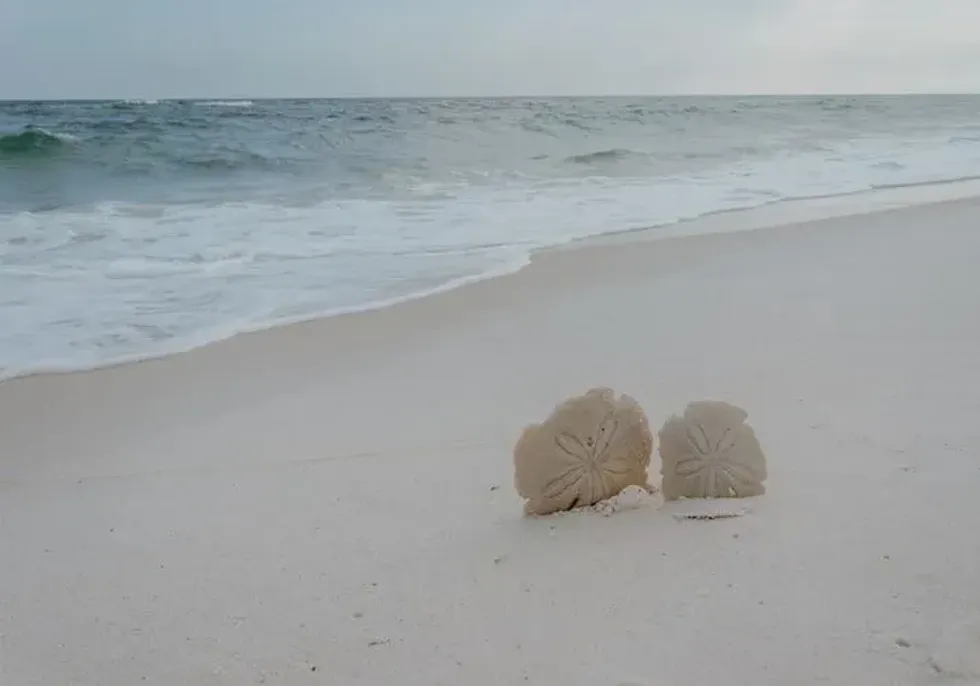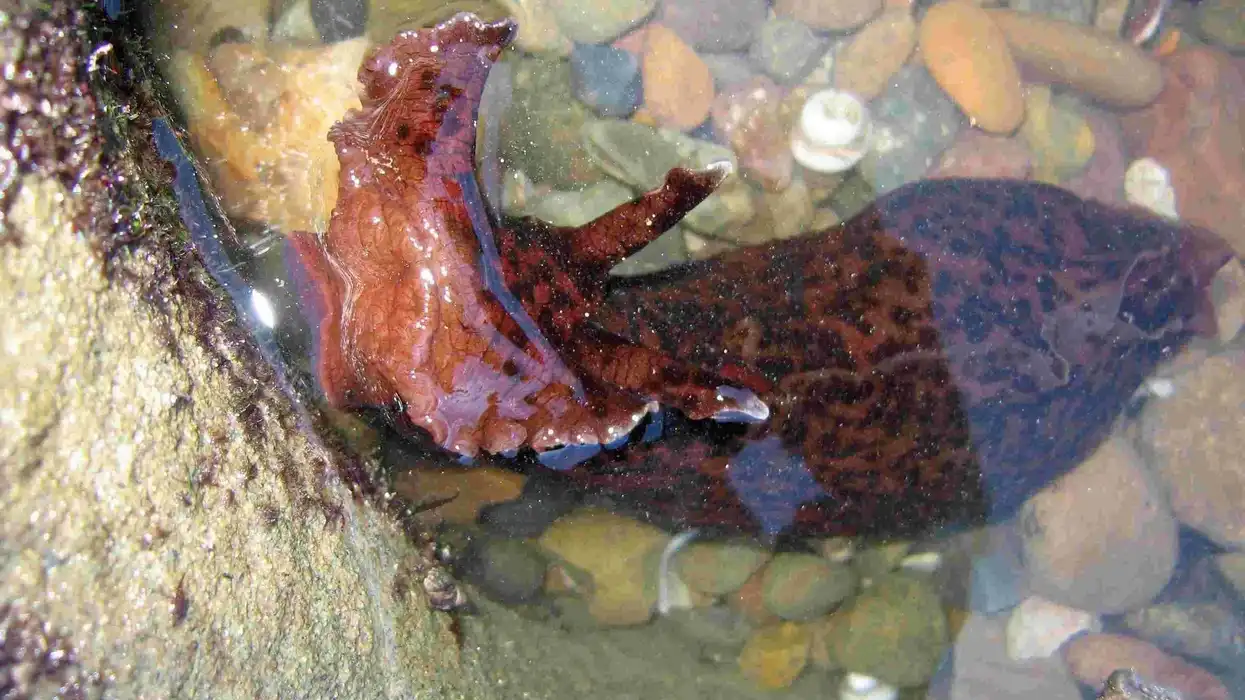A sand dollar is a disc-shaped, flattened invertebrate that is generally found in the coastal intertidal zone. They are located in temperate and tropical beaches or ocean floors of the Northern Hemisphere.
These marine beings are called sand dollars because their skin resembles a silver coin when soaked in the sun for some time. A sand dollar is usually found in sea urchins groups, which includes over 20 families, called colonies.
A sand dollar is known to have a flower-like pattern with holes and pores that helps them in their mobility and radial symmetry.
This flower-like pattern is called a petaloid. Their skeleton, also known as test, is made up of calcium bicarbonate and is identical to a star or a flower.
When the water current is high or rough, a sand dollar prefers lying down or burrowing under. They have minute hair-like projections called cilia that help them accomplish smooth movements.
While strolling through the beach or any seashore, it is considered good luck to come across some dead sand dollar skeleton or spines. The common sand dollar looks identical to a shell when they die, and a sand dollar alive is of different colors with a covering of cilia.
A sand dollar's body parts, such as its exoskeleton or spines, are often bought for decorative purposes and are worth whatever one can pay.
Sea animals often eat sand dollar larvae, and the common sand dollar dies when they have a lack of food in their surroundings or when they are eaten by urchins, sea stars, or some other sea animals.
So the next time you visit any coastal area or water body, you might be lucky enough to find living specimens of this species or even the larvae.
To know more about these fascinating animals, we have gathered a set of interesting facts about them for you to read. You can also read more articles on sucker fish and sea squirt.
Sand Dollar Interesting Facts
What type of animal is a Sand Dollar?
Sand dollars are a type of invertebrate and have a burrowing, flat, and rigid skeleton or exoskeleton body. They are flat marine animals known for their burrowing skills. They are closely related to sea urchins.
What class of animal does a Sand Dollar belong to?
Sand dollars are classified under or belong to the class of Echinoidea.
How many Sand Dollars are there in the world?
There is no such authentic and transparent data or numbers known about their population, but they're getting threatened with time.
Where does a Sand Dollar live?
A common sand dollar lives on the shallow coastal waters near the ocean floor. They generally prefer sandy and muddy regions, in the seashore and the foreshore. They are generally found in the ocean waters of the Northern Hemisphere. These are widespread and are mainly found in the Caribbean Sea.
What is a Sand Dollar's habitat?
Sand dollars are widespread and are found in the coastal areas. They are located in the intertidal zone: the foreshore or the seashore, which is the region above the low tide and the region below the high tide. In a nutshell, they are mostly spotted in sediment habitats.
Who do Sand Dollars live with?
Sand dollars generally live in colonies that are usually made up of two or more sand dollars living together to breed or catch their prey.
How long does a Sand Dollar live?
Sand dollars usually have a life expectancy of 6-10 years. As they have very few predators, they have a longer lifespan.
How do they reproduce?
Sand dollars are disk-shaped echinoderms, and they live in groups on the ocean floor as they find the intertidal zone easier for reproduction. Echinoids generally release their gametes into the water, and further, it is conceived by the female echinoid.
This phenomenon is known as external fertilization. They are broadcast spawners, and thus if one of them starts spawning, all the others begin to spawn.
This simultaneous spawning multiplies the prospects of reproduction, fertilization, and further on the endurance of the species. During spring and in August, spawning occurs quite a few times, and so throughout the year, a female sand dollar releases over 350,000 eggs.
Their offsprings are also known as nektonic larvae as they swim and drift in the currents of the ocean as they go through various developments and growth. Other sea creatures or animals often consume the larvae.
What is their conservation status?
Sand dollars are listed as Near Threatened under the IUCN Red List, and as they are found in the oceans, they need protection from from fishing and unregulated trawling as it poses harm to the species living on the seafloor.
Sand Dollar Fun Facts
What do Sand Dollars look like?
Sand dollars have a rigid outer covering made of the skeleton, called a test in sea urchins and other related species. A test is made up of five symmetrical plates of calcium bicarbonate, and these tests are often attached to them even after their death.
They are flat and round and token-like in shape, mainly responsible for the origination of their name, sand dollar, and their tests have velvety skin made of minutely textured spines that have cilia, thin hair-like projections.
These spines are often of blue, green, or purple colors, and that is how sand dollars get their adorable colors.
These textured spines also improve their movement and swiftness, which helps them coordinate movements that help them in their mobility in the waters. Their body resembles radial symmetry, with their mouths being at the center of their tests.

How cute are they?
Their adorable colors, purple, blue, and green amplifies their cuteness. Sand dollars are little disc-shaped sea urchins that have flower patterns all over their spines and body, and these patterns are their tubular feet which help them move. Thus, these are cute and adorable sea creatures. Their spines make them resemble a shell which increases their significance.
How do they communicate?
Sand dollars do not communicate, but they can sense things like pain. However, there are no known forms or modes of communication between these marine beings.
How big is a Sand Dollar?
Sand dollars are about 2-5 in (5-12.7 cm) long and are small disc-shaped animals. The largest sand dollar found is 6.3 in (16 cm). Seagulls are around ten times bigger than sand dollars.
How fast can Sand Dollars move?
There's no such authentic data analyzed for their speed. However, as they use their cilia, spines, and tubulated feet, they move considerably slow.
How much does a Sand Dollar weigh?
Sand dollars weigh less than 1 oz (28.3 g).
What are their male and female names of the species?
There are no such names given to them in terms of gender. Both male and female sand dollars are known as sand dollars.
What would you call a baby Sand Dollar?
A baby sand dollar does not have any such specific name, but they are often referred to as nektonic larvae.
What do they eat?
Sand dollars prey on zooplankton, phytoplankton, detritus, and algae. They also eat some edible particles that are found in the sand, which are mainly algae.
They also eat pieces of other creatures, and so they are classified as carnivores by the World Register of Marine Species.
They mainly use their spines to collect the food fragments. After being collected on the spines, food fragments are then delivered directly into their mouth, which is located at the center, with the help of their tubular feet, cilia, pincers, or pedicellaria.
Sea urchins, which are related species, generally place their edges in contact with the seafloor to multiply the prospects of catching prey that drifts by.
The mouth of a sand dollar is known as Aristotle's lantern, and likewise, every sea urchin's mouth is called Aristotle's lantern. It has been summarized that you may hear some rattling sounds from inside the oral opening when you hold and move the sand dollars gently.
Are they harmful?
Sand dollars are not harmful at all. Sand dollars produce echinochrome while they are alive, and echinochrome is a harmless substance that can change the color of your skin to yellow when held for a minute.
Would they make a good pet?
Sand dollars are not legally permitted to be kept as pets in most areas. Even in places where it is allowed or not restricted, it is recommended not to keep them as pets as they are not versatile, and so the artificial habitat can end up killing them.
The required habitat has to have coastal sea elements like sand and water. In a nutshell, they would not make a good pet.
Did you know...
Live sand dollars are found in the sea or the coastal waters. These live sand dollars are generally green, purple, or blue, whereas when they die, they turn white.
Sand dollars do not have eyes,a brain, and a heart.
A sand dollar's larvae clone themselves to save and defend themselves from sea stars or any of their predators.
Sand dollars have rings that can be used to estimate and predict the age of the individual sand dollars as the number of rings or loops multiplies with their age.
What is unique about the Sand Dollar?
Sand dollars are unique as they provide a major role in controlling the population of our ecosystem. They eat invertebrates, sea stars, and some other large organisms. These invertebrates are a symbol of hope and peace, as mentioned in the story of Christ.
Do people eat Sand Dollars?
No, people do not eat sand dollars. They don't even have enough meat, and their hard shell is made up of calcium bicarbonate.
Here at Kidadl, we have carefully created lots of interesting family-friendly animal facts for everyone to discover! Learn more about some other arthropods including barnacle, or sea snake.
You can even occupy yourself at home by drawing one on our Sand dollar coloring pages.










